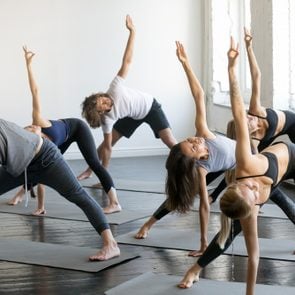Jumping Rope vs Running: Which Is Better for Exercise?
Updated: Feb. 24, 2021
Here's how the two cardio powerhouses measure up—and how to choose which one to incorporate into your routine.
Jumping rope vs. running
When it comes to picking the best do-anywhere cardio workout, both running and jumping rope stand out as top contenders. Both get your heart rate high, your lungs and heart working hard, and your body sweating.
They’re also both known for requiring little to no equipment. To run, you just need a good pair of sneakers. To jump rope, you just need, well, a jump rope. Both can be done outside, too, which is a major bonus for anyone looking for a change of scenery and some fresh air. (And doesn’t that describe all of us right about now?)
So, if you want to add more cardio to your exercise routine, which is better: jumping rope or running? The answer depends on a lot of factors. Here’s how to assess the pros and cons of each, and determine which activity is the best option for you.

Jumping rope: The pros
An efficient workout
Jumping rope is a great exercise to boost your heart rate and work your heart and lungs. Its ability to raise your heart rate quickly also means it’s a calorie-burner. You can turn up the intensity simply by jumping faster, or by using a weighted rope once you’re proficient—though, you’ll want to start with a regular speed rope if you’re new to it.
Strengthens your lower body
Jumping rope also builds strength in the lower body, says Jacque Crockford, certified personal trainer and exercise physiology content manager for the American Council on Exercise (ACE). Jumping quickly off the ground over and over again works the muscles in the lower legs and ankles. This motion puts stress on your body in a new way. Over time, building this quick, explosive strength can help prevent injuries when you’re doing other sports or activities, Crockford says.
Improves coordination
It’s also great for improving coordination. It requires significant mind-body communication to do successfully, says Kira Stokes, celebrity trainer and creator of the Kira Stokes Fit app. When you’re starting out, it’s likely going to feel really hard. It’s totally frustrating to not be good at a playground activity. But if you stick with it and practice, your coordination will improve and it’ll start to feel much easier.
Protects bones
Jumping rope can also work the core and arms, and help increase bone density. It involves impact, for sure. But if you jump only one or two inches off the ground, keep your knees bent as you land, and stay light on your toes, jumping rope can be less stressful on your joints than running.
Jumping rope: The cons
It can be boring
It’s really hard—mentally—to jump rope for a long time. It’s great for short cardio intervals or even a full 10-minute workout. But it can feel really monotonous to jump rope for much longer than that.
It takes practice
A lot of people also find it unenjoyable because it’s not easy to master. That’s normal, and with some practice, you’ll get better. But you do have to stick it out for a little while and practice regularly.
How to start jumping rope
Stokes suggests setting aside a small window of time, 10 minutes or so, each day to practice. Crockford likes using a jump rope as a form of cross-training. It also makes for a great cardio burst in between circuits of a strength workout, or a finisher at the end of a workout.
Like any other type of physical activity, you have to build up slowly to get your body used to the jumping motion and quick ground contact, says Crockford. “You will feel it the next day in your calves and ankles and legs.”
Just remember to ease into it: If you go too hard too fast, you can end up hurting yourself or just decide you hate how jumping rope makes you feel and quit before you can get into a groove. As you get better, you can try variations like single-leg jumping and alternate-leg jumping.

Running: The pros
Good for the heart and lungs
“Running in and of itself is a great cardiovascular activity,” says Crockford. You can run at your own pace, and make the workout as intense (running sprint intervals or tackling hills) or low-key (jogging at a leisurely pace) as you like. Even running slowly has great benefits for your heart and lungs.
Burns calories
Running burns a significant number of calories, and the faster and longer you run, the more you’ll burn. Interestingly, both jumping rope and running at an 8.5-mile-per-minute pace burn calories at a similar rate, according to The Adult Compendium of Physical Activities.
Boosts mood
A lot of people also find that running makes a huge difference in their mental health. Whether it’s a true runner’s high or just having a chunk of time to focus on your movement, maybe listen to music or a podcast, running can be a real stress reliever.
Even though we think of it primarily as a cardio workout, running also works the legs, glutes, and core. Running is a great exercise for maintaining healthy bones, too.
It also doesn’t require any specific skills. We all naturally know how to run. It doesn’t require the same sort of skills work that jumping rope does. That doesn’t mean running is easy. But most of us can just get up and go without stumbling over a piece of equipment.
Running: The cons
Injury risk
Running is also notorious for injuring people. According to Yale Medicine, at least 50 percent of regular runners get hurt each year. Most injuries are from overuse, which occurs when tendons, nerves, muscles, or any other part of the body, is subjected to the same strain over and over again. (Here are possible causes for lower back pain when running.)
Running puts a lot of impact on joints, but it isn’t necessarily bad or guaranteed to cause injury. The problem is that many people take up running and neglect to supplement it with cross-training that strengthens the muscles used and prepares the body for the impact.
If you run often and don’t do much else in terms of exercise, over time, the repetitive motion may contribute to injury, Crockford says. So you need to make sure you’re also stretching and strength training to keep your body healthy.
Takes a while to adjust to the workout
Also, if you’ve ever tried to start running, you know that it generally feels pretty awful for quite some time. It takes a while to get conditioned to running, to get to that point where it feels good and maybe even euphoric. It takes a lot of consistency and commitment to get into a routine.
How to start running
The best way to ease into a regular running habit is to mix it with walking. Try walking for four minutes and then running for one or two minutes; repeat that ratio for roughly 30 minutes. Do that for a few weeks, then decrease your walking time by a minute and up your running time by one minute. Keep shifting the ratio of running to walking as your body becomes accustomed to the demands.
The verdict
Jumping rope and running have many of the same benefits. The “better” of the two may depend on the situation. For example, if it’s snowy and icy outside and you don’t have a treadmill at home, jumping rope can be a convenient way to still get your heart rate high and check off your cardio workout for the day. If the weather is gorgeous, get out there and enjoy a run—or head to the park with your rope and play around a bit.
If you have arthritis or any existing joint injuries or issues, you’ll want to talk to your doctor before taking up either activity.
And always, always, always, start slow. Going 100 mph out of the gates with either running or jumping rope is a surefire way to get injured, burn out, and resent the activity. The best way to stay injury-free and learn to actually enjoy jumping rope or running? Start with just a few minutes, go at a leisurely pace, and work up both speed and time or distance.
On that note, your choice of jumping rope vs. running may just come down to which activity you enjoy more. There’s nothing wrong with that. The best exercise really is the exercise you’ll actually do and stick with. Give them both a try, and follow your fast-beating heart.



